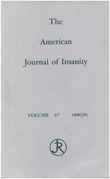Body dysmorphic disorder in the DSM-IV field trial for obsessive- compulsive disorder
Abstract
OBJECTIVE: This study investigated the prevalence and phenomenology of body dysmorphic disorder in patients with obsessive-compulsive disorder. METHOD: The authors studied 442 patients who participated in the DSM-IV field trial for obsessive-compulsive disorder. RESULTS: Twelve percent (N = 51) of the patients had a lifetime comorbid diagnosis of body dysmorphic disorder. Patients with and without body dysmorphic disorder did not differ in demographic characteristics of obsessive-compulsive symptoms. Patients with obsessive-compulsive disorder and body dysmorphic disorder had more anxious, impulsive, and schizotypal features than patients with obsessive-compulsive disorder alone. Age at onset was similar for the two disorders, and severity correlated. However, insight was significantly more impaired for body dysmorphic disorder than for obsessive-compulsive disorder. CONCLUSIONS: As previously thought, these findings suggest that the two disorders are strongly related but also have differences that require further investigation.
Access content
To read the fulltext, please use one of the options below to sign in or purchase access.- Personal login
- Institutional Login
- Sign in via OpenAthens
- Register for access
-
Please login/register if you wish to pair your device and check access availability.
Not a subscriber?
PsychiatryOnline subscription options offer access to the DSM-5 library, books, journals, CME, and patient resources. This all-in-one virtual library provides psychiatrists and mental health professionals with key resources for diagnosis, treatment, research, and professional development.
Need more help? PsychiatryOnline Customer Service may be reached by emailing [email protected] or by calling 800-368-5777 (in the U.S.) or 703-907-7322 (outside the U.S.).



